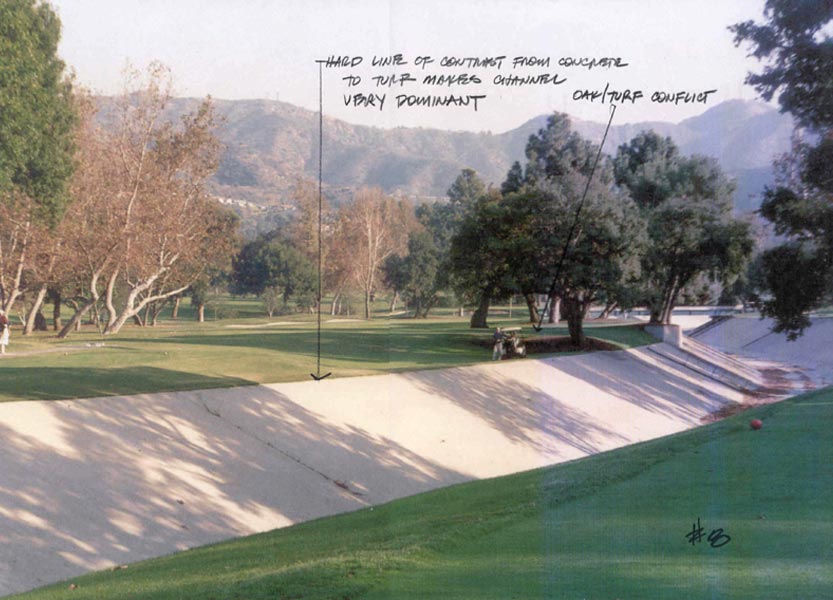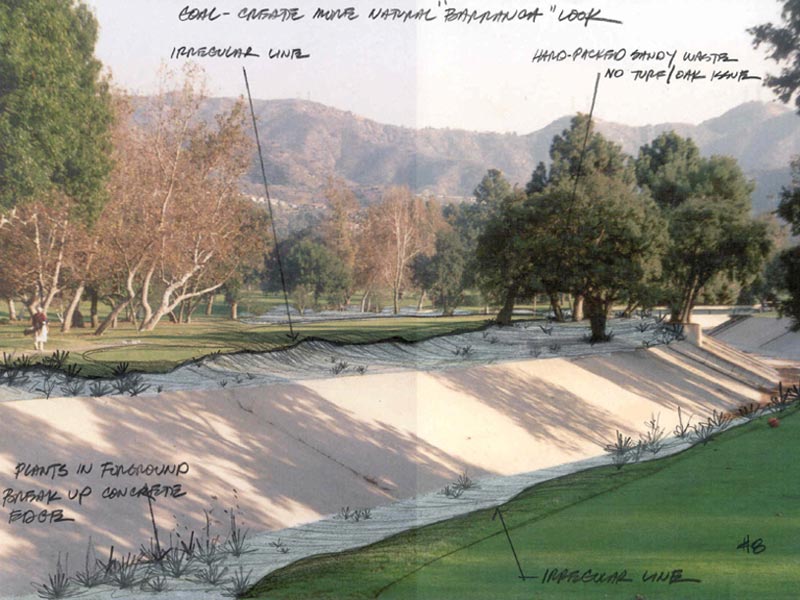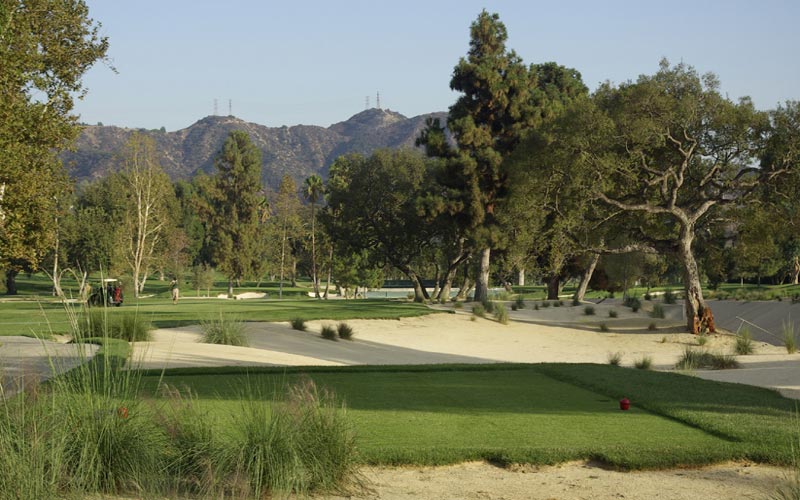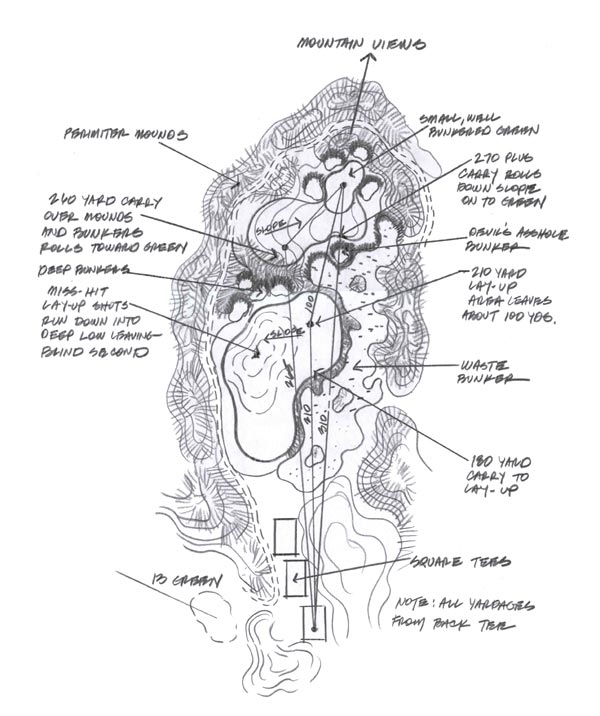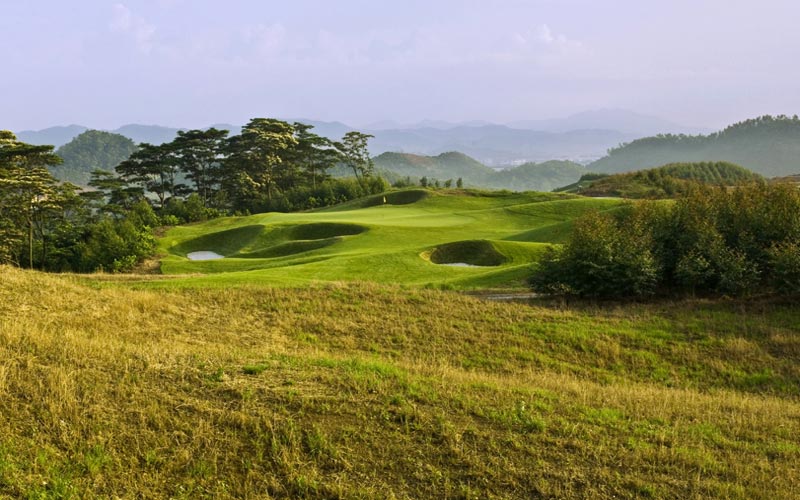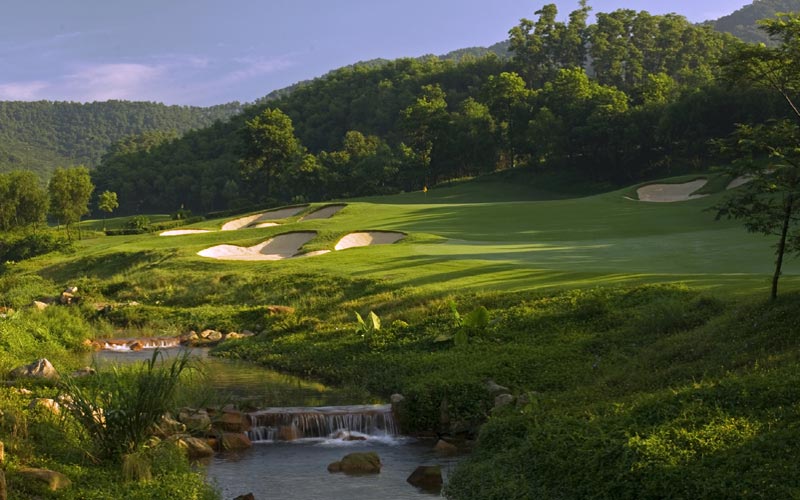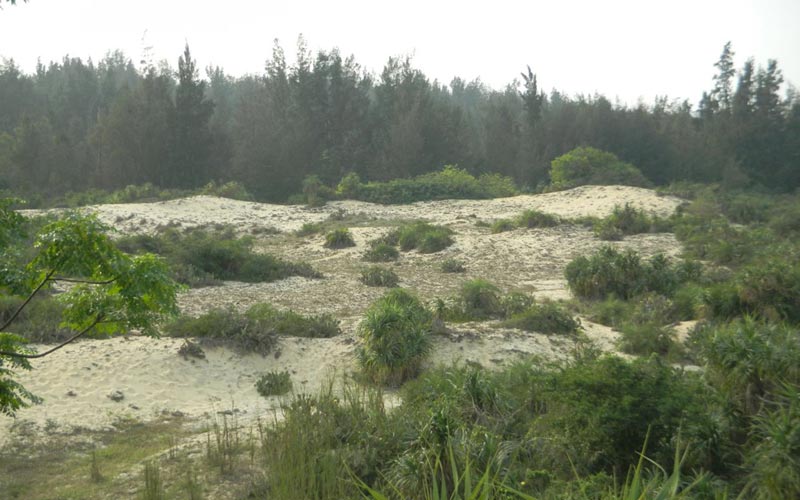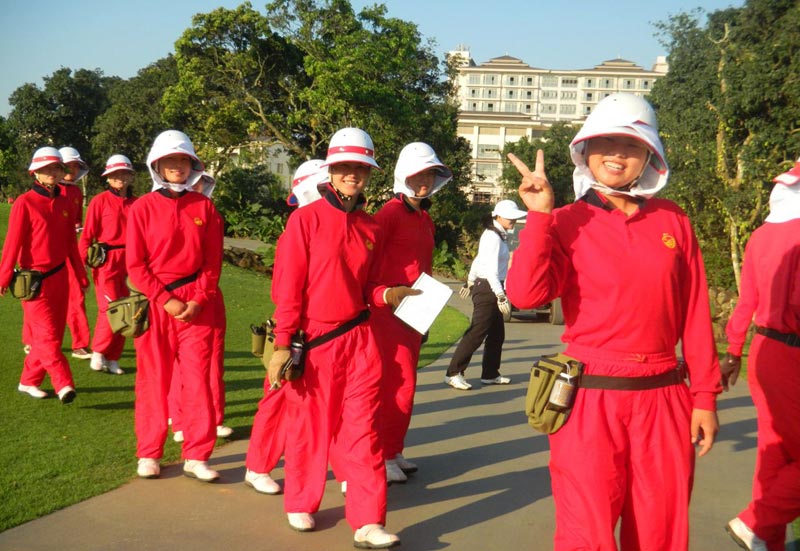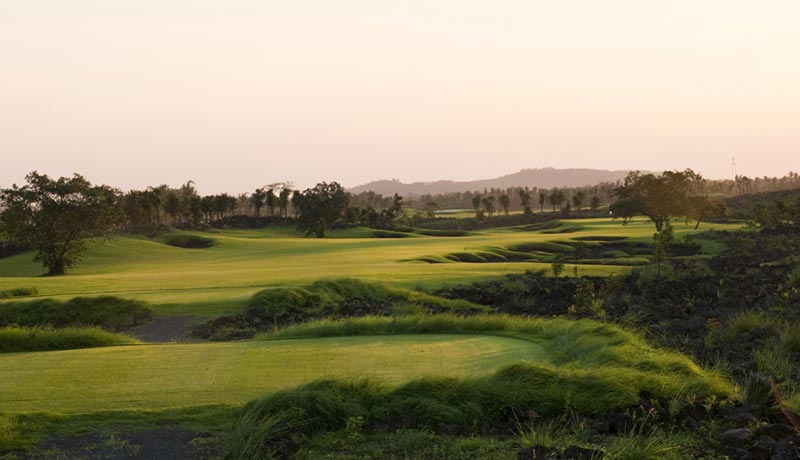Feature Interview with Brian Curley
August, 2010
1. You grew up on the Monterey Peninsula. How did exposure to its great courses affect your design philosophies?
I grew up in Pebble Beach just through the trees near Spyglass (If #12 were a par 4, the green would be at our house). I worked the range and carts at Spyglass and occasionally caddied there, as well as Pebble and Cypress Point. The neighborhood kids and I used to play every day sneaking on all the courses…I learned to play fast and walk along the tree lines to avoid getting caught! These courses were basically my only barometer of what a golf course should be (occasionally we played the par 3 course, Peter Hay.) Given these formative experiences with some of the toughest and most beautiful courses in the world, I have always felt comfortable around and designing courses on the far end of the difficulty scale. (Although I have tried to produce courses that are “find your ball†tough vs. “lose your ball†tough.) I also have always tried to employ the “Out like a lamb, In like a lion†philosophy often attributed to Pebble Beach…Warm ‘em up before you knock ‘em down.
I went to Pacific Grove High School (where my father was the principal) and played on the golf team. Our home course was Pacific Grove Golf Links where I was suddenly around a different caliber of course. I truly enjoyed the new atmosphere and its short, tight nature, especially the dunes-scaped front nine (now the back nine.) I spent countless hours on great courses in a golf-fanatic environment and have been immersed in the culture ever since.
Along the way, I think I have always carried a strong understanding of what makes quality courses and experiences. While most of my early professional work (at Landmark Land Company) focused on late 80’s, early 90’s golf communities such as PGA West and La Quinta, the opportunities to work on any sites or development plans similar to the Peninsula Courses did not come until recently. We’re currently doing stand-alone golf on some outstanding sites (including ocean-front sand dunes), so I feel my design experience and knowledge is peaking at an opportune time when better sites are coming our way. If we can pull off courses that compare with those of the Monterey Peninsula, it will be quite an accomplishment and the fulfillment of a dream since the age of 13.
2. Is there a particular architect from golf’s “Golden Age†who you’re particularly fond of? If so, who and what about his designs make them so appealing?
I realize it is the standard answer for architects today but, obviously, growing up through the trees from Cypress Point, I hold MacKenzie in high regard. Cypress, for numerous reasons, is my favorite course in the world. Due to my familiarity with it, I feel I can comfortably make this statement – too many people rate courses off quick, one-time (sometimes wind shielded) reviews. I feel one needs to know a course in all kinds of conditions, weather, etc. over numerous rounds before passing too strong of a judgment. I’ve warmed-up and cooled-off to some highly regarded courses as I have seen them over time. I have always praised Cypress Point for MacKenzie’s willingness to break all the rules on conventional design, especially in regards to hole sequences.
Given my West Coast roots, I certainly respect George Thomas as well, especially Los Angeles CC’s North Course (which is currently undergoing a nice restoration with Gil Hanse and Geoff Shackelford). Much of our Southern California work has a similar bunkering and design philosophy. We built Goose Creek near Riverside to be “the poor man’s Riviera.â€
Having worked so much with Pete Dye early in my career, I was really excited when first exposed to Seth Raynor’s work. You can see the influence on Pete, yet those courses look so old.
The funny thing is that, recently, the period’s greatest influence is less the iconic designers and courses but more the odd shapes, forms and features on courses that never survived. In researching ideas for one of the courses at the new Mission Hills Haikou project, we really wanted to push the envelope — not only craft a course that plays and feels like a “Golden Age†design, but also incorporates as many quirky traits as possible.

Mission Hills Haikou C Course – Lay of the land, traditions with the occasional odd funky features.
Our firm was involved with a remodel at Annandale Golf Club in Pasadena a few years ago – a course first built with oil greens, bee hive mounds, and odd, funky geometric shapes that have since faded away with time. With this experience in mind, I asked one of our design associates, Ryan Farrow, to do extensive research of old photos looking for ideas. We made two stacks — one we would somewhat emulate and one we would not. I wanted, however, to show the construction teams that second set of photos just to open their minds — the reactions were priceless!
We just gave the photos we selected to the shapers for a quick look. We didn’t want replicas, just funky, weird and different. The course at Mission Hills Haikou is lay of the land and natural at most times, but then something wacky knocks you in the head. In keeping with older courses I wanted few fairway bunkers, opting largely for tree-lined, wide, turf areas. Upon opening, players thought it was too easy off the tee (no patience for trees to grow) so I added features. Given that the ground is rock, we couldn’t dig down so we built up (with hand labor) odd bee hives, chocolate drops in sandy expanses and more, much the way a course would have been developed 100 years ago. It will be a bit of an experiment to see how it is accepted by Chinese golfers but I love it and it is a lot of fun to play. To describe it, I’ve been using the line,â€the oldest course in China is a new course in Haikou.â€
3. Max Behr had one of the great minds in golf course architecture and yet unfortunately, much of his work has not stood the test of time very well. Tell us about the work that you completed in 2009 at his Oakmont Country Club design in Glendale, CA. Did you bring back many of his features?
There was little to go off of, other than an old aerial photo that became instrumental to shaping our main design theme. The course had been transformed from a rugged, sandy expanse punctuated by clusters of oaks surrounding an open barranca, to a wall-to-wall turf parkland course with a harsh concrete flood channel through its center. I asked Southern California golf historian Tommy Naccarato for some additional historical help but not much was found. Geoff Shackelford sent me some of Behr’s writings which were useful as general thoughts and guidelines, but we lacked specifics about the course itself. Billy Bell had done bunker work (similar to Riviera) but the course had suffered from multiple years of Boards adding a hodge-podge of “improvements.†The great thing is the current board was aware of the issues and looking for a cohesive plan.
Our number one priority was to visually convert the hard-lined concrete channel into a natural looking barranca. This was done by altering the top edge (in plan view) by creating irregularly shaped and edged sandy expanses that we coined a “California native look.†I made an effort to play with a cross section of members to get them onboard with the concept. I had done a number of different routing options, one of which was fairly drastic and, I thought, had no chance of flying. Much to my surprise they decided on this option and the course now has a much stronger run of finishing holes. Another big improvement was the elimination of all the “clutter†(curbs, hedges, planter beds, etc.). That was a bit of a tough sell but everyone was amazed by how much it improved the overall look of a more expansive property rather than 18 tight corridors. We’re all very happy with the results and hope to use this as approach and business plan for any future remodel we undertake.
4. 2% of golfers now hit the ball obscene distances. Do you build in features to handle such (relatively few) players or do you stay focused on the other 98% of players?
I am not sure where the 2% number comes from, but I think the percentage is much higher. After a 10-year hiatus from playing much (due to being busy and a bad back) I am playing more and hit it further than I ever did. Still, it seems like I am consistently out-driven by most of my friends. When we first opened Southern Dunes, it seemed like all the membership hit it 300 yards. A good percentage of golfers hit it stupid long and stupid off-center compared to 1975. No industry-produced statistics will convince me otherwise.
With that said, yes, there is a huge gap and most golfers do not see the significant added length. I feel we have been as active as anyone in developing courses that fit the common man’s game and it is my mission to break Asia of the scorecard wars.
The new Hainan Island project for Mission Hills has some courses that will be tough and challenge the best players (for instance the Blackstone Course, slated to host a celebrity pro-am in October and the World Cup in 2011, can play to 7,777 yards). However we were also able to design courses for the common golfer. Some are par 70, 6,400 yards or so or less). It was a huge accomplishment to convince ownership to build the course that everyone wants to play: a bit easier and at a comfortable yardage. I hope that Mission Hills, with the industry-leading position it holds, will help pull golf back to reality and show that it is about the experience, not the scorecard. We are now getting clients who “see the light.†We have some awesome courses set to open that break the mold. The “big†courses are there if you want them, but we also designed shorter, friendlier ones including two par-three layouts. I am very optimistic that we will help show Chinese golfers and developers it is more about offering a great experience (that may or may not involve length) and less about presenting some standard scorecard. In time, people will warm up to a walkable, average-length course that challenges the golfer on levels other than the scorecard alone. Like I’ve always said, nobody has done a list of Top 100 scorecards…yet. It is an odd thought, but with the rest of the world slowed down, China may carry the torch in regard to new design trends.
5. Maintenance costs continue to escalate given golfers’ lofty expectations regarding course conditioning. Especially in light of the severe current economic conditions in golf, are there certain hallmarks you use in your projects to ease the maintenance burden on superintendents and owners alike?
We have always (for the most part) tried to create landforms over mounds and other labor-intensive features. But our Asian clients tend to want more of a “wow factor.†As warm season grass courses lack the wispy roughs that keep players in check, bunkering becomes more of a defining feature. I learned long ago (while working on PGA West) that more relaxed grades are invariably correlated with better conditioning. We have done some very successful courses that employ 10-man crews (Goose Creek for instance). At the same time, China has little problem with labor intensive maintenance as costs are a fraction of Western budgets. I have even had ownership tell me they need places to send local villagers to work – consequently a labor-intensive course can be a positive.
6. A popular design element today is incorporating at least one short, drivable par 4. Is this something you often employ? Are there particular aspects that such holes must ideally include to make them interesting? Please explain one such hole that you have designed and what you like so much about it.
I love the short par 4. We have integrated it numerous times but I would say my favorite is #14 at Southern Dunes in Phoenix, Arizona. From a flat cotton field we created a wonderful design that has seen its ups and downs (currently on an uptick) but has always remained a highly regarded course. Number 14 boasts several distinguishing traits including the widest fairway on the course, despite its length.
Most short, drivable par 4’s seem to incorporate water as a main deterrent in the risk – reward theme. This hole, however, does so much with a huge sandy expanse and native grasses. Playing at about 325 yards, you have four basic options:
1. Hit a tee shot in the 210 yard range up to the right side, flirting with the long bunker and native grasses. This leaves an open view to the green about 100 yards away.
2. Hit the same length shot but left, safely away from the sand. This 75 yard wide fairway, however, has a deep depression that swallows shots leaving a blind second to a tiny green.
3. Carry the bunkers long left with a shot of about 260 yards. Strong slope to the right and fairway cut will send the ball rolling towards, but not on the green.
4. Take it directly at the green about 310 yards on a straight line. You must carry a deep, devils asshole bunker but, if successful, the grades behind send the ball straight to the green. However, hitting driver brings sand and native into play for slightly errant shots.
7. You and your partner Lee Schmidt had the good fortune of working alongside Pete Dye before starting your firm. What’s the most important lesson you learned from him?
Pete’s influence has been monstrous. You have to know Pete but his mannerisms combined with his design sense are incomparable. They broke the mold with him and I cannot express how influential he was and continues to be from design, to dealing with clients, to his knack for just getting things done. I owe a great deal of my professional success to Pete – he saw something in me years ago (about 1984 when we were building PGA West) and has been an inspiration and mentor ever since. I am so grateful to have had the opportunity to be around him, travel with him, do his plans, etc. I think he has always been comfortable with my work, from PGA West to Kiawah to past and current projects in China. We have a current deal on a world-class site in China that rivals Cypress Point and cherish the chance to work with him once again. I know Lee feels the same – their relationship goes way back to Pete’s early days in Indiana. I think Pete was always concerned about angles more than threading the needle and, as premier players got longer and better, was always concerned about keeping the best players in check. Alice, however, keeps him grounded with her emphasis on getting the average player around.
A favorite story of mine is when Pete – after witnessing my ability to draw and never one to miss out on the opportunity for a one-liner — told me, “it’s nice to be able to draw but, it’s more important to draw a paycheck.†He is a classic and his aw-shucks Midwestern personality could sell snow to Eskimos. It is one reason why he is so successful – this business requires salesmanship especially if you are doing “different.â€
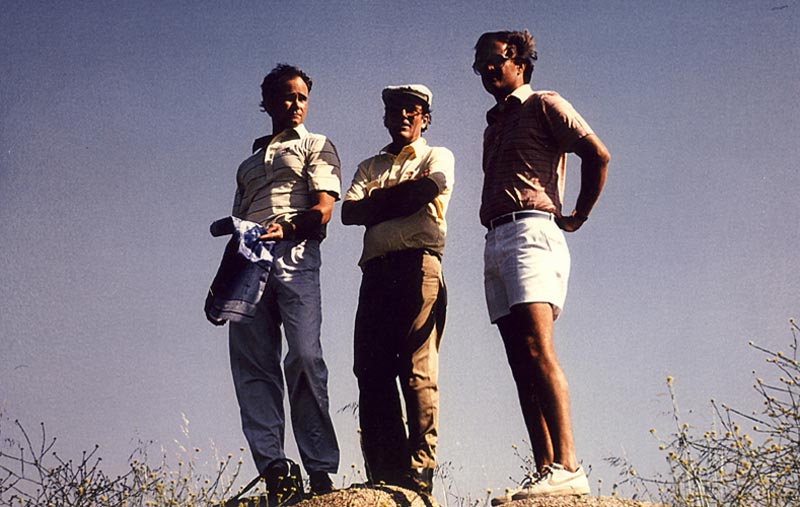
With Pete and Lee circa 1988, when I still had hair and Lee was sporting the “short shorts lookâ€.
8. You’ve worked with many Tour players during your career (e.g. Nick Faldo, Fred Couples, and Ernie Els, to name a few). How does the design process differ when collaborating with a Tour player versus working by yourself?
Generally not much, but I do feel a responsibility to adhere to their wishes/design concepts. Although their input may be limited, I feel like the quarterback asked to execute their game plan. I usually do a photo image of options that gives them an opportunity to give general directions. The final decisions may be largely mine, but I always stick to the general guidelines as their name is associated with the final product. If they want “black,†I may venture into “grey,†but I would never go to “white.â€
Their time may be restricted but their opinions remain strong. Most are unaware of the heavy lifting required prior to deciding where to place features. I have found all but a few very appreciative and very willing to learn. Contrary to common belief, they do not bring a “take the money and run†attitude but are, rather, eager to be involved though available time is typically short. Some of the stronger personalities sometimes are a bit more reserved on site when a crowd is around for fear they may say something wrong or stupid. Often when we are finally away from the cameras and crowd, they will be much more vocal in their criticism, concerns, input, etc. I’ll say, “Why didn’t you tell me back on 15?†Overall, it’s been a great experience and it has not only lead us to better jobs but I’ve made some good friends along the way.
9. Please tell us what it was like to oversee the simultaneous construction of five courses (Annika, Duval, Leadbetter, Norman and Olazabal) at China’s Mission Hills from late 2002 to early 2004.
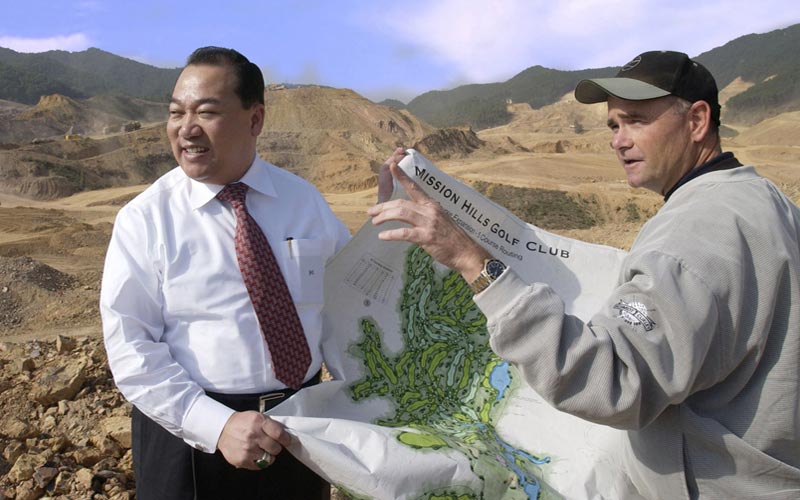
Mission Hills Dongguan – Just after Clearing for the Five Courses. Chairman Dr. David Chu. Note the Extent of Area to be Graded.
It was wild, fun, fast and furious, and it started well outside our typical “comfort zoneâ€. We were given a master topo made up of a few rudimentary topos spliced together with five-, 10-, sometimes 20-meter contour intervals that did not match very well. The 2,000-plus acres were on a plan that measured maybe 30 inches wide (topos in China can be an adventure). We spliced it together and enlarged it to make a base – my initial fear was it would be off by 10% or more and our courses would shrink. Just after clearing (the site was dense trees on mostly 1:1 or 2:1 slopes), our construction superintendent, Ray Scofield, measured a couple of points some 1,000 meters apart. I think we were off by about 5% in some places but it all worked out. We made 20-, 30-, 40-, 50-meter cuts and fills just to manhandle the property into something resembling golf-friendly terrain in just over six months. We moved approximately 40 million cubic meters with over 2,000 trucks and excavators working 24 hours a day. On our peak day I think we moved some 350,000 cubic meters. We were irrigating a hole a day and sometimes grassing 2 holes a day. At a time when “minimalism†was all the talk in golf design, we flipped the script. The speed and statistics are unbelievable, and all on a rocky site that needed blasting three times a day — it would rain rock for huge distances.
I think there are two kinds of architecture 0 adaptive and creative. Adaptive Architecture employs a lay of the land, minimal disturbance philosophy looking for natural features. Creative architecture takes a totally flat (think Shadow Creek) or severe terrain (such as Mission Hills which was largely unwalkable) and requires extensive work in order to bring the site into the realm of golf friendly terrain. Not many architects are experienced with the latter.
It was an awesome experience with a great team of shapers, laborers, etc. managed by Martin Moore and our sister company, Flagstick. The huge crew overtook the nearby town Da Ping, and the camaraderie was great. We had something like 60 Thais that, at the end of the day, threw rooftop Bar- B- Q’s. I could go on forever with stories and thought “this will never be done again.†Then came Mission Hills Haikou…
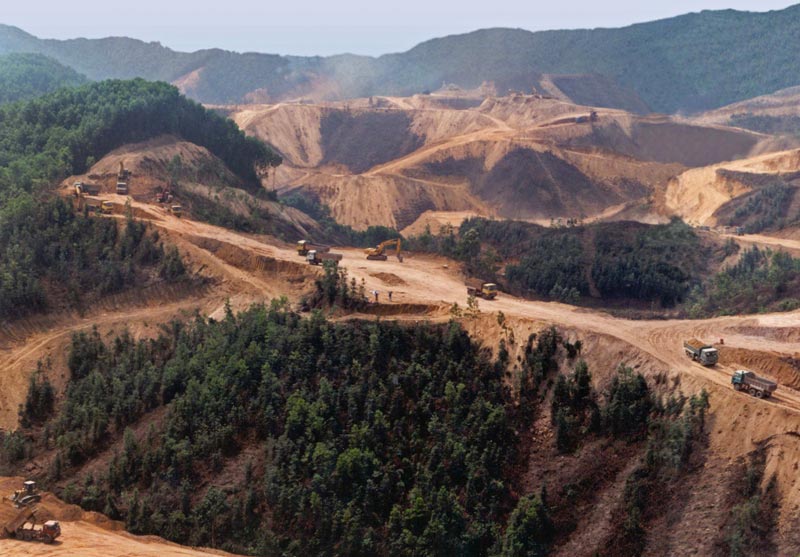
Mission Hills Dongguan – Construction Sequence for Norman & Leadbetter Courses, 30 & 40 Meter Cuts & Fill to Come.
10. What steps did you take to ensure each course you designed at Mission Hills provided a varied and distinct playing experience?
On the first project, the sites had many things in common, including a backdrop of tall forested hillsides. Another similarity was the turf conditions and climate issues unique to southwest China. Warm-season grasses dictate a certain design to ensure playability – tall, wispy cool season grasses are not an option, so you either have low-mow or snake habitat where you can’t find your ball if you step on it. Consequently, you tend to adhere to a cleaner look rather than rugged and natural. This also was in line with management’s and golfers’ desires for the “standard†par-72, 7,000-yard-plus formula.
The first course, the Nicklaus-designed World Cup, was completed prior to my involvement, as was a second course by Nicklaus (then known as the Valley Course). We subsequently added land and converted it to the Els and Vijay Courses. Because much of the Els used existing Nicklaus holes, the new holes were fashioned to match. As a result, the courses are similar in look and playability. The Vijay Course is spread over a flatter side of the property. It has a TPC Sawgrass-feel, with a lot of narrow waterways and long, sandy waste areas.
The Faldo layout includes many stadium course influences. It has an elaborate but clean bunker look and is a very good set up for tournaments as the last five holes sit in a valley overlooked by the clubhouse. Included is an island-green par 3 at #16, something Vice Chairman Ken Chu requested and we were happy to incorporate. Nick was very pleased with the course and we have since worked with him on a number of others with him. Nick is one of the more “involved†players by the way, and has a good eye.
The Pete Dye Course is wild with all the trademark features you might expect from one of his designs – and then some.
There is also a Par 3 Course that highlights different green designs through the ages. It was inspired by the fact that China missed out on the early days of golf architecture and jumped straight into the 80’s/contemporary designs with the omnipresent kidney- and figure eight- shaped bunkers. It starts with a square-edged, Chicago Golf Club-look, and then moves onto other iconic green styles like the moat hole, punch bowl, redan, biarritz, etc. It is a cool little course – really fun to grab a few clubs and play. What was an odd, small parcel became a hugely successful real estate project (about 100 units sold in Phase One at $1,000,000 each in one day). It is a great amenity and a good break from the norm.
The Dongguan Property and its five courses were a bit more influenced by the tour players. We assembled a matrix-like study of different bunker styles, tee shapes, green concepts, landscape, turf types, etc. When meeting with each player, we tried to put together a program representing their wishes. As noted earlier, our role is to present their design concepts and make sure the final product is as good as it can be. The Leadbetter and Annika offer comparable bunker styles, and the Norman looks similar to the Olazabal (which was well underway when Greg’s team got involved). I was hoping to nudge David Duval toward a rugged look, but he wanted something a bit more traditional – let’s call it a Donald Ross-ish look.
Looking back on the designs, there are very few things that seem wrong or structurally incorrect. However, if I’d had total control, I would have pushed the limits a bit more. That takes us to Mission Hills Haikou where we have carte blanche and are trying our best to create not only different looks and playability on the ten courses, but also big scorecard variations.
11. Although Schmidt-Curley Design is based in Scottsdale, you opened an office on China’s Hainan Island in 2007. That seems quite prescient now given how golf course design opportunities practically halted in North America in September 2008. Did you see something that the rest of us didn’t? Is Asia likely to fall into the same bad habits of overbuilding real estate courses as what happened in the United States?
While we didn’t have a crystal ball, we did have a general sense that golf’s popularity would wane in North America. From a macro point of view, we felt strongly that the golf climate might begin to decline following the September 11th terrorist attacks. At the same time, our firm was dealing with a failing club in Phoenix (Southern Dunes…a long story). We saw a future of reduced play and heard first-hand all the reasons golfers were cutting back most of which seemed to center on the lack of time. I would often hold court in the office when builders would visit and talk about “the light at the end of the tunnel.†I predicted double-digit attrition in golf facilities long before the economic collapse. Golf doesn’t have an economic problem, it has a golf problem. Operators, in my opinion, are too slow to adapt to changing times. I was recently sent an e-mail from a club asking the membership if it was okay to bend the “no denim†rule at the clubhouse for one night…a cowboy cookout theme.
I am afraid that younger golfers will take a pass on golf. You cannot tell a prospective 35 year old member he has to give up his Blackberry for five hours. Times have changed.
Golf is a great game with a long history and it’s not going away but, with the quick advances in technology and multi-tasking mentalities it will need to adjust. I’ve told operators they should get rid of the G.P.S. screens on carts (that you bump your head on) and change it to E.S.P.N.!
This certainly isn’t the case for all courses (Augusta is certainly in no dire need to “adaptâ€) but some courses will need to do so to survive.
Asia, on the other hand, is different. The sport is new and exciting. Plus, unlike the Western World, they embrace combining business with golf. Women play more. Families promote golf to children as a tool to advance in business. I have been fairly outspoken in outlining the differences.
Moreover, golf is a social game and Asians — especially Chinese — are very social. Americans change their shoes in the parking lot and want a quick round in order to get back to their other responsibilities and family. To many Asians, the golf club and its expansive clubhouses that get ridiculed by the West represent their family/social scene. They are not afraid of multi-tasking. Cell phones are not only everywhere, but you will see signs boasting cell service quality at clubhouses and on first tees.
I am not saying one view is “right,†and the other “wrong†— it is just the state of our world today and I think Western operators could learn something from how Asian clubs function. China never got the early “rules†of golf and adapted the game to their culture. There is no old guy at the back of the room wearing a blue blazer with dandruff exclaiming, “That’s the way we did it back when Hogan played here.â€
Will they over build? They could. But the real estate situation in China, in my opinion, is drastically different. Buyers purchase often with cash, not “no money down financing.†In addition, they have more units and density (more people paying dues) and the cost of maintenance is far less. There is a course in Kunming with over 6,000 units around it – it may not be the greatest golf experience but it will always have a full tee sheet. If necessary, courses can also more easily survive with fewer players, as buyers are there to get away from the sea of humanity in the cities and enjoy open space. That model does not work at a 300-unit club in California with a $4,000,000 operations budget.
12. What design opportunities are you presently working on across Asia?
We are very active with a number of outstanding sites and clients. China is our main focus, but we are also working in Thailand, Korea and Palau. I enjoy working in China and we have developed a well-oiled machine that is humming along very well. Our clients (mostly repeat) receive great design and service. With fully-staffed offices in Haikou and Kunming, we can make site visits on short notice and are immersed in the Asian golf scene. We strive to create happy clients as well as great golf.
I am very excited about a current 54-hole project outside Kunming called Stone Forest. The site is beyond spectacular and will be as photogenic as anything on the planet. The courses have a “natural†feel that blends in and does not distract from the stone… The first course will open this Fall, the last next Spring.
On Hainan Island, we obviously have a full plate with ten courses are Mission Hills, some of which will really push the limits of golf design. I came to realize that, while our roots are in sport and golf traditions, we are also competing for someone’s free – time and are, in effect, in the entertainment business as well. I have no problem rocking the boat of conventional wisdom and have plans that will make a Desmond Muirhead course look like a pony ride; it may not please the purist but I think that golfers are looking for more than the same, “been there – done that†experience.
Also on Hainan we have a few sites on nicely vegetated dunesland overlooking the ocean that will be tremendous. It may or may not rival Bandon but it will be close and the climate is great year round.
13. Asia is a beautiful part of the world but many of the sites where courses are built have required all sorts of earth moving and are cart ball courses only. Why would a traditionalist travel to Asia?
More walking experiences exist than many think, and the reference to “cart ball courses†is not entirely correct. For instance, at Mission Hills each player has a female caddie. While the cart stays on the path, she runs clubs back and forth so you can walk all you want. The caddies speak broken English and add to the overall enjoyment and uniqueness of the golf.
The new Haikou courses are located on flatter terrain than those in Shenzhen and are eminently walkable, core courses. Real estate is primarily located on the periphery. They are very traditional in many respects and signal Asian golf’s continuing evolution.
14. China has both high humidity and a monsoon season. Are there any ways to promote ground game options or is golf in that part of the world all aerial based?
I have been very pleased with our recent courses using Paspalum If not overwatered, it presents plenty of opportunity for the ground game, especially with fairway cuts around greens. I have found that drives get plenty of roll. In fact, when combined with a little bit of slope and surface-flow drainage, I feel there is plenty of roll and would not want much more.
Ryan Farrow and I played at Bandon Dunes earlier this month and we both felt that while there were certainly more firm conditions there, our latest courses were not far behind. The advantages of Paspalum are huge.
We try to incorporate wider fairways with speedslots, kick slopes, “fingers†that send balls 90 degrees, feeder slopes to back pins, etc. Width is good not only for avid golfers but to accommodate new players. I like Paspalum greens as you can incorporate much more slope and movement than bent and its fast speeds. We also have, on the Haikou tournament course, gone to all fairway/no rough. Post monsoons will certainly see slower conditions but I am pleased overall.
15. Since founding Schmidt-Curley in 1997, you have worked on more than 100 courses in twenty-four countries including such diverse locations as Mexico, Thailand, and Egypt. How have advances in turf helped you in such hot, humid places?
One word: Paspalum. We often go wall-to-wall. It gives you so many tools to work with. Maintenance is simplified –many course workers are new to the game and can learn one grass thereby avoiding contamination issues. The ability to alter fairway cuts is a breeze and it is dense with great color. It stripes up a bit more than Bermuda, but not anywhere as harsh as Bent or Rye grass. I love it. The only potential drawback we’ve noticed is that, keeping it from being overwatered can be a bit of a challenge with inexperienced superintendants.
16. Rough edged, more natural courses have gained favor in the United States in recent years yet Asians typically prefer a garden/park like ambience. Have you built any courses in Asia with wild, wooly bunkers and large tracts of native grasses? Or are all the courses various shades of green?
Not to the extent of, say, a Sand Hills-look, but yes, we have. Again, the key is cool-season grasses. In Haikou, we have what I would refer to as more of a “natural†look with a lot of transitional bunkering, and irregular turf lines and bunker edges and tall Bahia Grass. I think surface flow is crucial. With a flatter property and no watershed issues, we can avoid the catch basins needed on other sites where steep terrain and seasonal typhoons are a lethal combination.
Developers can still be a bit difficult to convince, but the trend is starting. That said, some owners respond that with such a look “my friends will think I have no money to pay for maintenance.â€
17. Nine Bridges is the only Asian course currently ranked in the world top 100 by GOLF Magazine. Should there be others and if so, which ones?
I have yet to see Nine Bridges, but these lists can be tough to crack. I think China will soon have a number of courses deserving the accolade and expect that as Asia’s influence on the world golf stage increases we’ll see more recognized. It may just take a longer time before it is formally noted.
18. What are the advantages and disadvantages in working in a region where golf has only existed for twenty years?
Many owners are complete novices. We had one project where payments were way behind so, I thought I could try “nice†rather than mean or threatening. So, I brought the owner a Masters jacket as a way to win him over. He looked at it and I explained to the translator it was from the Masters…You know, Augusta…You know, green jacket…You know, big famous course in the U.S….all to a confused look. He just kind of set it down and changed the subject. Not sure it worked as I think we are still about a year behind still on payments!
I have no regrets. Other architects used to ask me why we work in Asia (too far away, nobody sees your work, etc.) but I have had a great time doing what I love in a bit of a new frontier. Mission Hills has not only been a great experience from a design point of view, but I feel our work has helped influence new generations of golfers. It has also helped a large number of Chinese and Thai workers make a better life for their families. Working overseas with a large team away from friends and family creates a much different living environment and camaraderie. We have employees who will someday carry the torch after years of mentoring. Sport is a great ice breaker and helps bridge cultural gaps — we are doing our best to do so with golf.
19. What differences are there in working in Asia? What should architects looking to venture into China be aware of?
Asia is different on multiple levels. On one hand, jobs can go fast (although very few ever go as fast as they first promise). As most know, China is in the midst of a moratorium on golf construction and illegally built courses do get shut down on occasion. So, not only are developers taking major risks but architects need to be aware the job they were promised can vanish in a heartbeat.
Farmland and villager issues are huge and not going away. It is very common to begin construction on a project, only to be told that land first planned for development has disappeared and the property line has changed causing a total change of plans…and “we need it yesterday.â€
Essentially all clients’ expect and demand a lot of up-front work…for free…before they decide who to use. They will use these plans to work competing bids and can make promises that often go unfulfilled. A number of architects get concerned that their plans will be used with no contract or payment…and they will. We had a client who (despite my radar telling me to stay away when we first negotiated) was cordial for most of the project but, later built a second course that we provided plans for yet never were paid. He turned into the guy I first met and I felt lucky to make it out of his office with a substantially reduced final payment offered on a “take it or leave it†basis.
We found a project selling memberships touting us as the designers although we had nothing to do with the course.
Then, you want to get paid. Sometimes you have to wait a long time, sometimes you may never see a dime. We have been largely very fortunate as we have many five-star clients. But there can be major hiccups. We are large enough to ride the ups and downs.
In the U.S., you have legal avenues when all these issues arise. But, in Asia, are you going to sue? We have decided a few times to take our lumps and move on.
As for quality, it is all over the map. Some clients (such as Mission Hills) are awesome but many talk the talk but don’t quite walk the walk. Lee and I have, on some past occasions, had the attitude that we can do well to just end up with something that resembles a decent course – there are so many moving parts and so much out of your control.
You need thick skin as far as claiming responsibility for design goes. Despite your best intentions the final project may venture into a zone of strangeness with less than perfect results…Yet the client may still be very happy so it is difficult to make adjustments. If you are concerned about criticism, beware. But that is the nature of the business, even in the U.S. We did a course in Southern California where the promise was made that a small, yet blind, blue – line stream was to be filled in the first landing area of a par 5. It never happened. Now golfers think I’m some idiot for designing such a poor hole. Whatever you do for a living (bus driver, ambulance man, chicken inspector) you go home and nobody criticizes your work. In this business you are the face behind the good and bad. I’m not saying it has happened often to us often but the lethal combination of difficult site, novice owners, inexperienced contractors and fast construction timelines of construction can lead you to poor results. We diligently stay on top of construction management to stay on top of these issues, but I’ve seen plenty of courses with numerous issues. There are so many moving parts and so much out of your control.
That said, I do believe that more and more excellent courses will be built. Owners are aware of more and are a bit more willing to break out of their comfort zone and a lot of bad product gets redone after a year or so. I am very confident about upcoming work.
I think we’ve done well holding to our standards but it takes a big effort and organization.
20. You have ruffled some feathers at the annual ASGCA Conference by performing a song every year. You appeared in Sports Illustrated for taking shots at the USGA and most recently painted a brutally honest picture of the state of the golf industry. What topic can we see headlining next year’s conference?
Those came about when Forrest Richardson asked me to do a song to break up our ASGCA meetings – He coined them “Blitz Sessionsâ€. I told him fine but I’m not singing “Kumbaya†– I wanted to keep current, topical, somewhat controversial if needed.
My first one was a reaction to a student who had called asking how to get into the business. At the time, it seemed like every golf critic was becoming an architect so I wrote “The Confidential Guide to Becoming a Golf Course Architect†which, as one might guess, ruffled some feathers. It somehow got misrepresented as “the minimalism blues†which was not the tone at all.
The USGA song was a good one. Based on “Y.M.C.A.†by the Village People, it came at a time when the USGA was being criticized by a lot of people so, it being an easy target, I piled on! Sports Illustrated ran a little piece on it and the Golf Channel called to use it during the Open week but backed off when they feared getting sued (from the Village People – not the USGA).
In Seattle, being Kurt Cobain’s home turf, I did “Smells like Golf Contractionâ€â€¦(“Load up on jobs while you still can before this business sees the endâ€). Kind of a bummer tone but a sign of the times.
Last year was in Ponte Vedra where we played T.P.C. Sawgrass I knew Pete and Alice would be there so I did the Credence song “Born on the Bayou†as “Built on a Bayou†(then one day a man named Beaman came ‘round – saying “come on down to Florida with me†– he gave Pete a swamp and backhoe – and said, “Build me a T.P.C.â€) When we finished, Pete stood up and said, “ I knew you were good for somethingâ€.
Next year is in Denver but I haven’t given it much thought yet. I usually write the lyrics on the plane at the last minute. I may have to go John Denver on them…
Our little band is made up of Brit Stinson, John Lafoy, and Shane Whitcomb and we call ourselves “The Stiff Shafts†although Forrest has a tough time announcing us that way! It’s all fun; I love music and really love playing in China. About a sand wedge away from our Kunming office is a little hole in the wall club called the “Double Happiness Barâ€. I sometimes play for hours on end at night with the local musicians who walk in. Music is a true bridge builder and it keeps me fresh…much better than watching pirated movies. And besides…what good is sitting alone in your room – come hear the music play.
The End



